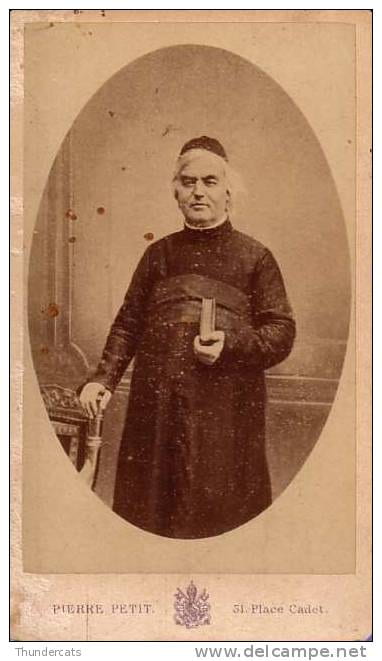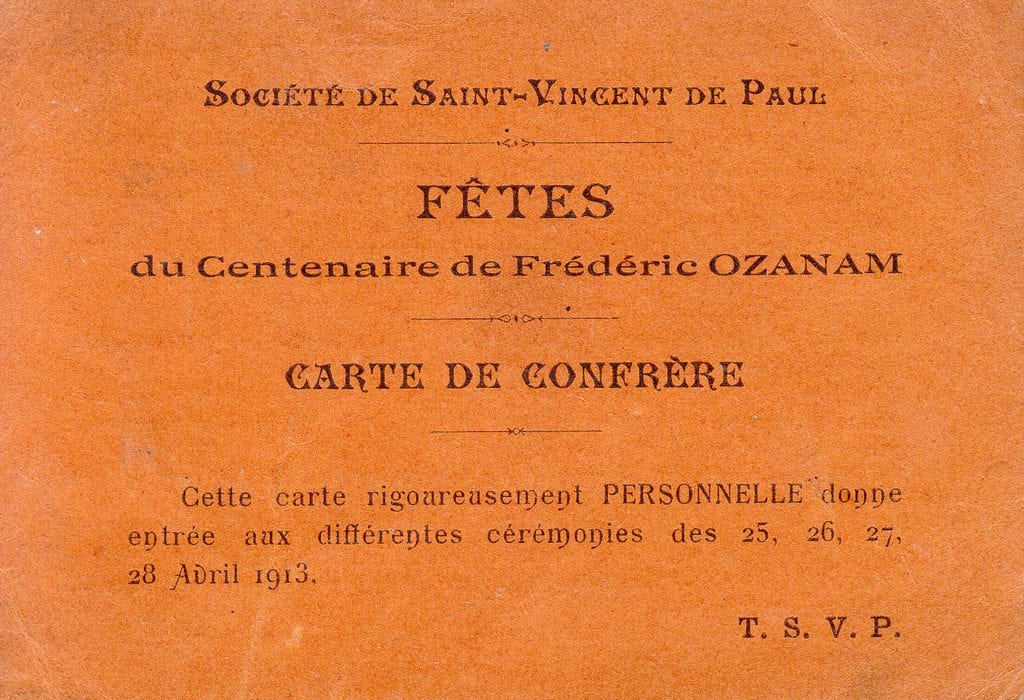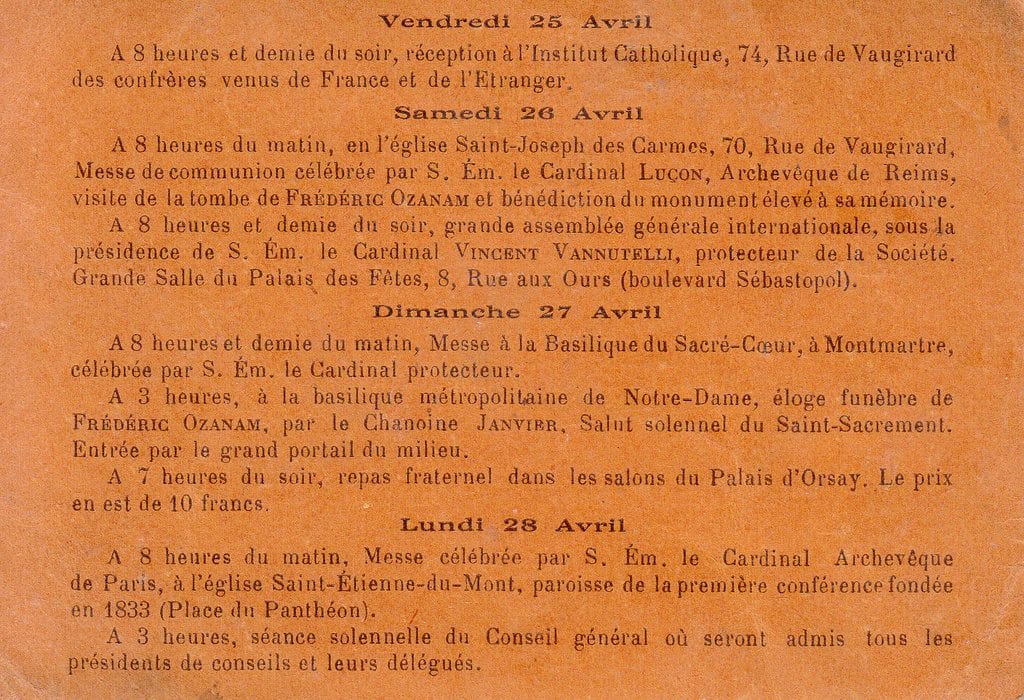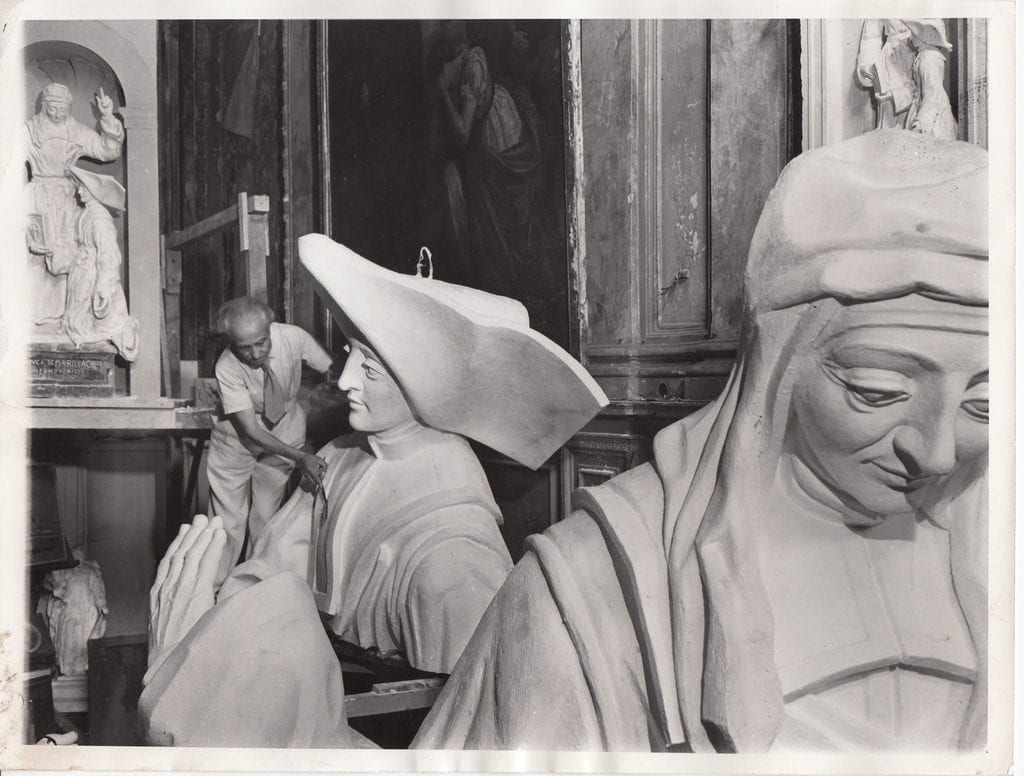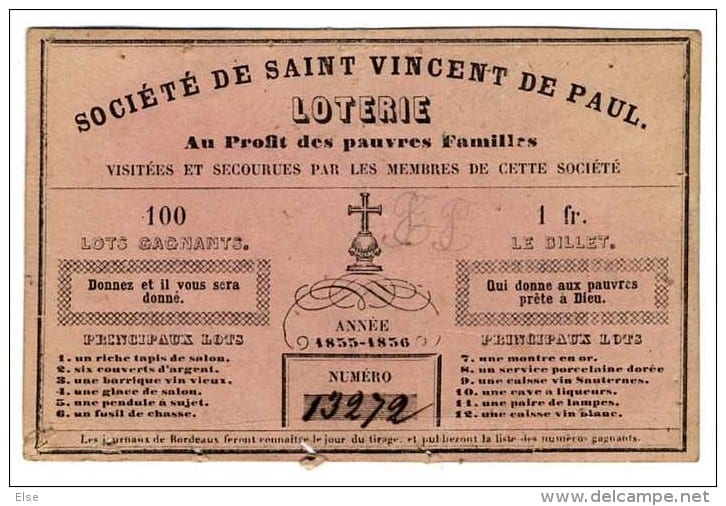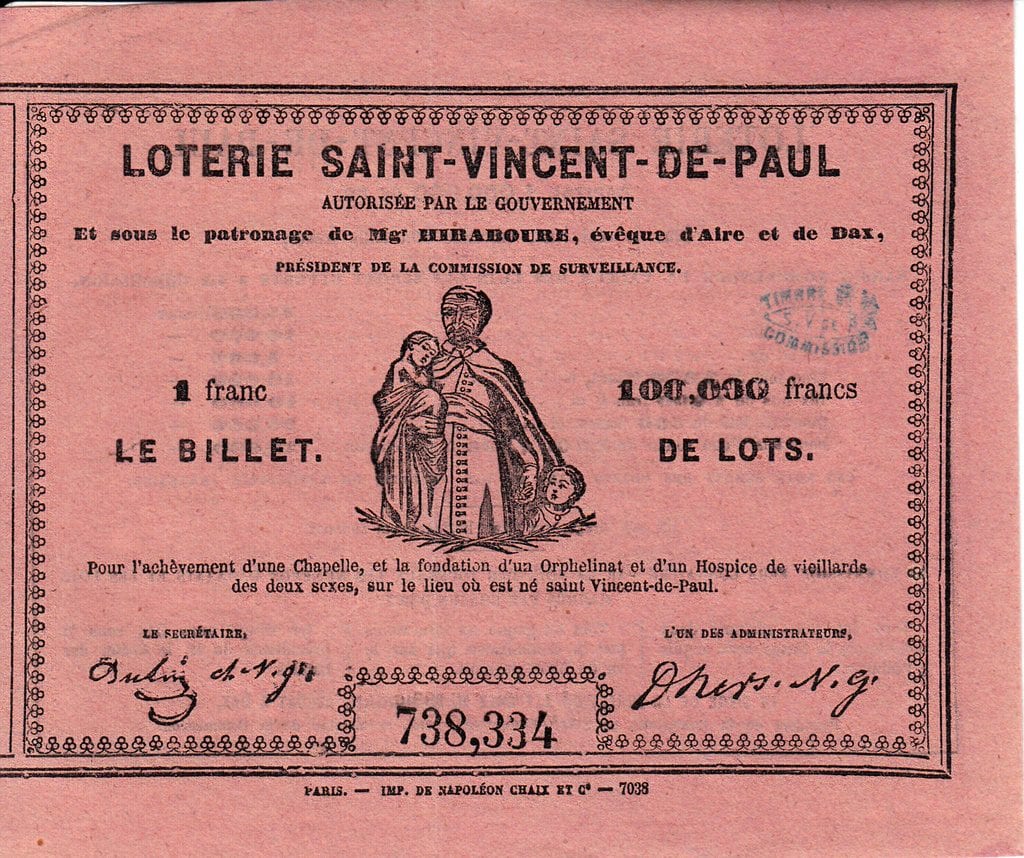As a companion to the carte de visite previously highlighted this image of Jean-Baptiste Etienne appears to have been taken very close in time to the other image recently purchased. This interior shot was undoubtedly taken at the maison-mere on the rue de Sevres. The chair on which Etienne rests his hand is the same chair as in the previous photograph. The chair is still preserved at the maison-mere. Interestingly, the Empire style chair is also featured in one of the monumental paintings by Bro. Francois Carbonnier that are in display in the tribune of the mother house chapel.
archives
Ozanam Centennial and Bicentennial
2013 marked the bicentennial of the birth of Frederic Ozanam. The year that is about to end witnessed a large number of celebrations in Paris and world-wide for the anniversary. The Vincentiana collection at the John T. Richardson Library at DePaul University in Chicago has recently acquired a copy of the announcement for the centennial celebration held in Paris in April 1913. The card appears below:
Louise de Marillac’s Statue in St. Peter’s Basilica, Rome
The Vincentiana Collection in Archives/Special Collections at DePaul University’s John T. Richardson Library has recently acquired this 1947 press photo. The text reads:
“SCULPTURE READIED FOR ST. PETER’S BASILICA ROME: Professor A. Silva, official Vatican artist puts the finishing touches to the head of the sculpture of the recently canonized Louise de Marillac, founder of the order of the Sisters of Charity. The statue, which is made after model at top right, will be twenty feet high, in accordance with the normal size of statutes in St. Peter’s Basilica, where it will be erected.”
ACME Photo by Julius Humi, Staff Correspondent, 9/27/47
Rare St. Vincent de Paul Society item acquired
The Vincentiana Collection at DePaul University’s Richardson Libarary’s Archives and Special Collections Department has recently acquired an early example of a St. Vincent de Paul Society fundraiser for the poor. The lottery took place in Bordeaux in 1855-1856. The various prizes for the lottery are listed on the ticket which cost one livre. From its origins, the Society employed a number of different types of fundraising to support its ministries to the poor.
Rare Ozanam Volume Acquired
The Vincentian Studies Institute has acquired a first edition of Frederic Ozanam’s 1840 work: “Dante et la Philosophie Catholique au treizieme siecle,” (Paris: Olivier-Fulgence, 1840). This volume will be added to the V.S.I.’s special collections at the John T. Richardson Library of DePaul University in Chicago.
Rare Rosalie Rendu Print Acquired
The Vincentiana Collection located at the Special Collections and Archives of DePaul University has recently acquired a rare 19th century print depicting a famous incident involving Rosalie Rendu during the 1848 revolution in Paris. For more information see Sr. Louise Sullivan’s 2006 biography: Sister Rosalie Rendu: A Daughter of Charity On Fire with Love for the Poor,
Recent Acquisition: Mother Suzanne Guillemin, D.C. (1906-1968)
The Vincentiana Collection at the Archives/Special Collections Department of DePaul University’s Richardson Library has recently acquired a press photograph from September 30, 1964 showing Mother Suzanne Guillemin of the Daughters of Charity attending a session of the Second Vatican Council. Appointed by Pope John XIII, Mother Guillemin was among a number of heads of womens communities who were invited to the Council in a revolutionary act by the pope. Interestingly this picture was taken only days after the Daughters of Charity switched from their traditional habit and cornette.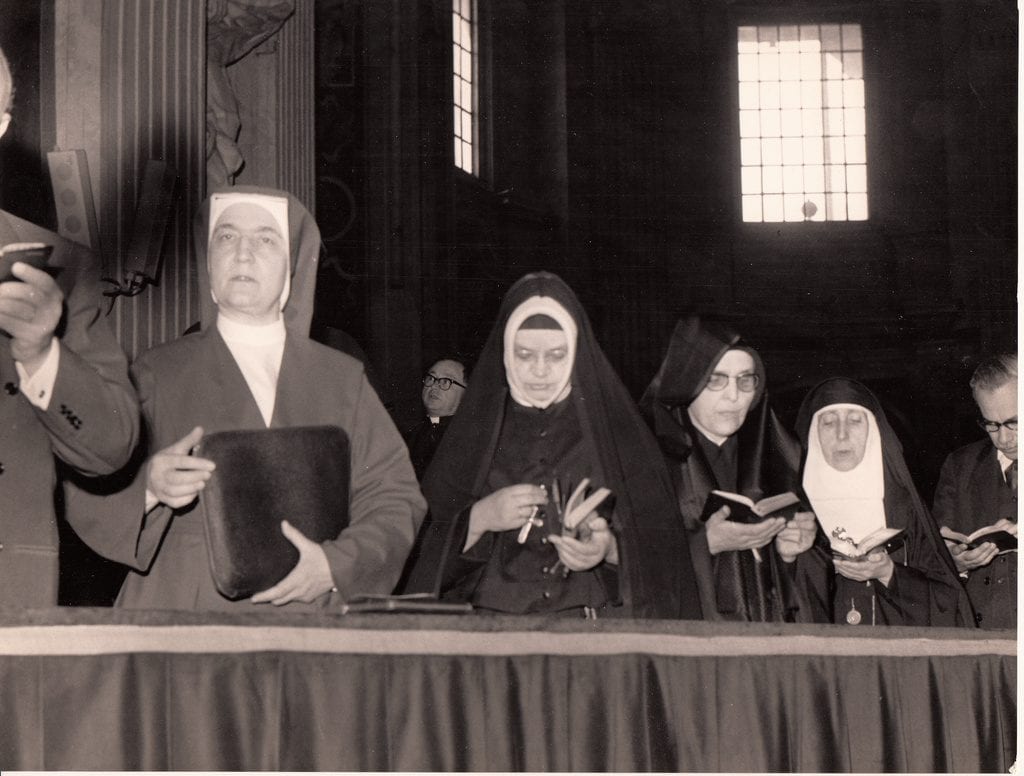
Recent Acquisition: “Loterie Saint-Vincent-De-Paul.”
The Vincentiana Collection of the Archives/Special Collections department at DePaul University recently acquired a lottery ticket that was issued to raise money for the mid-nineteenth century construction of the shrine complex at Saint Vincent’s birthplace “Le Berceau” near Dax. This national lottery which was authorized by the government of Napoleon III was headed by the Bishop of Aire/Dax, Mgr. Hiraboure. The stated purpose of the lottery was to raise funds to erect a chapel, orphange, and rest home at the site of St. Vincent’s birth. The lottery distributed 100,000 francs in prize money. The shrine complex (which also included the reconstructed “birth place” of Saint Vincent and the famous 800 year old oak tree) was dedicated with great solemnity on 24 April 1864.
Book of the Week: “Saint Francois de Sales et la Contre-Reforme”
Aimé Richardt, Saint François de Sales et la Contre-Réforme, Paris: François-Xavier de Guibert, 2013. Pp. 269. ISBN 978-207554-0553-8. 25,90.
“C’est souvent dans les périodes difficiles que surgissent d’authentiques témoins de la foi chrétienne. François de Sales est l’un de ceux-là.
Cet homme qui vit à la charnière de deux siècles, au lendemain du concile de Trne don’t il s’emploie à appliquer la réforme, est une personnalité de premier ordre. Né à Thorens, aux abords d’Annecy, aux portes de Genève don’t il deviendra l’évêque, c’est à tous égards un «homme de frontières» que nous présente avec talen Aimé Richardt.
Personnalité marquant de la »renaissance catholique«, qu’il s’agisse de convertir les protestants de son diocèse ou d’initier la vie religieuse, la force de François de Sales était tout entière celle de l’Amour, d’un amour puisé dans l’amour même de Dieu, don’t il a su parler mieux que personne dans le fameux Traité qui porte ce titre.
Cet amour de Dieu est pour lui inséparable de l’amour de l’Église, comme il le soulignait lui-même en citant saint Cyprien: «Nul ne peut avoird Dieur pour père qui n’aura cette Église pour mère.»
Cet home énergique alliait avec bonheur bon sens et couceur, et cet amouor a eu une fécondite extraordinaire. Outre la Visitation fondée avec Jeanne de Chantal et qui, trente ans après, comptera quatre-vingt-dix monastères en Europe, il existe ou a existé aussi au mons ving instituts féminins et six masculins qui se sont inspirés de sa doctrine spirituelle, en particulier les Salésiens de Dom Bosco, ces grands éducateurs. C’est en reconnaissance de sa dette spirtuelle que le Bienheureux Newman prendra comme devise de cardinal ce mot de François de Sales: Cor a cor loquitur, le cœur parle au cœurs.”
Specialiste des XVIe et XVIIe siècles, Aimé RICHARDT a publié de nombreux ouvrages, dont un Fénelon couronné par l’Académie française. Parmi ses derniers ouvrages parus: Calvin, Érasme et Henri VIII ou le schisme anglican.
